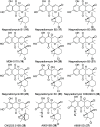MAR4 Streptomyces: A Unique Resource for Natural Product Discovery
- PMID: 38353658
- PMCID: PMC10897937
- DOI: 10.1021/acs.jnatprod.3c01007
MAR4 Streptomyces: A Unique Resource for Natural Product Discovery
Abstract
Marine-derived Streptomyces have long been recognized as a source of novel, pharmaceutically relevant natural products. Among these bacteria, the MAR4 clade within the genus Streptomyces has been identified as metabolically rich, yielding over 93 different compounds to date. MAR4 strains are particularly noteworthy for the production of halogenated hybrid isoprenoid natural products, a relatively rare class of bacterial metabolites that possess a wide range of biological activities. MAR4 genomes are enriched in vanadium haloperoxidase and prenyltransferase genes, thus accounting for the production of these compounds. Functional characterization of the enzymes encoded in MAR4 genomes has advanced our understanding of halogenated, hybrid isoprenoid biosynthesis. Despite the exceptional biosynthetic capabilities of MAR4 bacteria, the large body of research they have stimulated has yet to be compiled. Here we review 35 years of natural product research on MAR4 strains and update the molecular diversity of this unique group of bacteria.
Conflict of interest statement
The authors declare no competing financial interest.
Figures















References
-
- Miller T. W.; Chaiet L.; Cole D. J.; Cole L. J.; Flor J. E.; Goegelman R. T.; Gullo V. P.; Joshua H.; Kempf A. J.; Krellwitz W. R.; Monaghan R. L.; Ormond R. E.; Wilson K. E.; Albers-Schönberg G.; Putter I. Avermectins, New Family of Potent Anthelmintic Agents: Isolation and Chromatographic Properties. Antimicrob. Agents Chemother. 1979, 15 (3), 368–371. 10.1128/AAC.15.3.368. - DOI - PMC - PubMed
-
- Trejo W. H. Section of Microbiology: An Evaluation of Some Concepts and Criteria Used in the Speciation of Streptomycetes. Trans. N. Y. Acad. Sci. 1970, 32 (8), 989–997. 10.1111/j.2164-0947.1970.tb02991.x. - DOI

